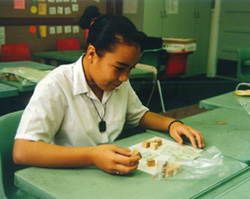![]() STUDENTS’ MATHEMATICAL CONJECTURES AND JUSTIFICATIONS
STUDENTS’ MATHEMATICAL CONJECTURES AND JUSTIFICATIONS
![]()
Glenda
Anthony and Margaret Walshaw
A pervasive theme emerging from mathematics education discussions
in recent years is the issue of students’ active engagement
with mathematical ideas. This theme also focuses on establishing
inquiry-based classrooms that allow students to communicate their
ideas. Communication is looked at closely in this study in relation
to commutative and identity rules in mathematics. |
Data
were collected from random samples of 50 Year 4 and 50 Year 8 students
on five NEMP tasks. These tasks required students to justify their responses
verbally and by manipulating cubes to illustrate commutative and identity
rules in mathematics.
•
Is 4 plus 3 the same as 3 plus 4? |
•
Is there a number you can add to or take away from this number
[7] but the number still stays the same?
|
![]()
If students are to realise that learning and doing mathematics involves solving problems in ways that are meaningful, classroom instruction must encourage and support discussion and reflection on the mathematics structure of number from an early age. More specifically, in relation to the assessment tasks analysed in this project, when students genuinely understand arithmetical ideas and can explain and justify the properties that they are using as they carry out calculations, they have learned the foundations of concepts belonging to algebra.
